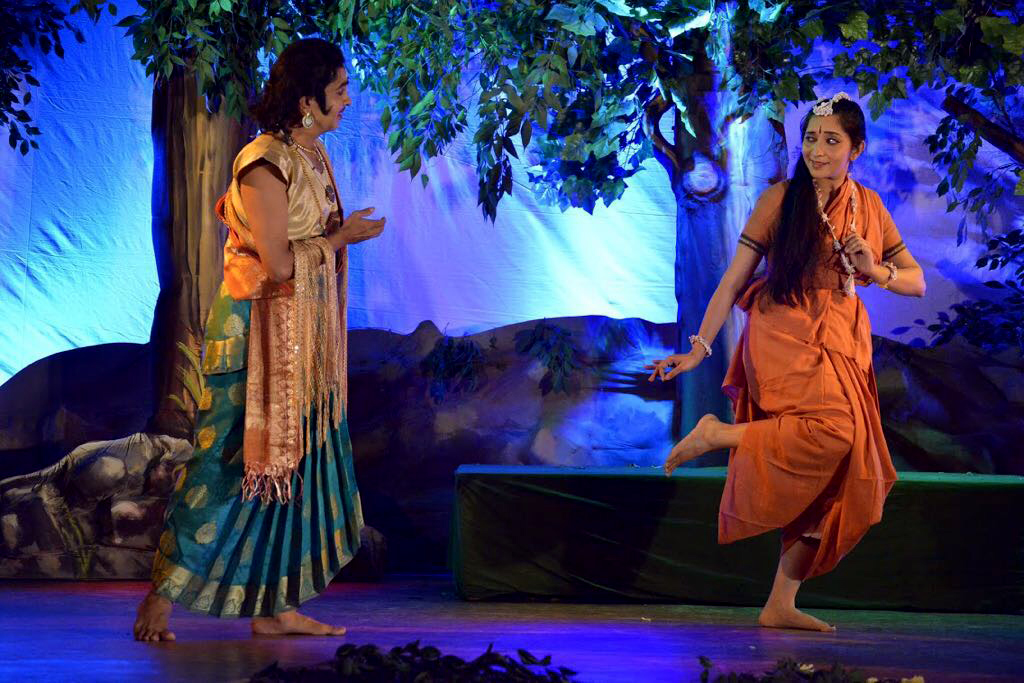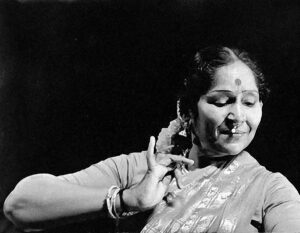Every Indian classical art form flourishing today derives its theory and practice from the rich source material available in the medium of Sanskrit language. More so for the evolution and development of fine arts and its varied branches in India, this glorious language and its literature have provided the solid base.
Modern Indian Drama was for many decades merely a pale copy of Western theatre; but beginning with the establishment of the National School of Drama in 1959 there has been a renaissance of traditional dramatic forms. Especially notable is the revival of Sanskrit Drama and its well-conceived presentation of not only classical plays but plays on modern subject as well.
The Samskrita Ranga, Madras, founded by the eminent Sanskrit Scholar Dr. V. Raghavan, has since its inception in 1958 and earlier through All India Radio has been playing an important role in making Sanskrit Drama a healthy Performing Art again. In spite of financial limitations, the Samskrita Ranga has been, for five decades now striving for the propagation of Sanskrit Drama. The Ranga celebrated its 50th year in 2008 which happily coincided with the Centenary of its illustrious Founder.
It will be apt to recall at this point, some very special moments in Samskrita Ranga’s activities over the years. The Ranga’s obvious choice for its inaugural performance in 1958 was a Kālidāsa play, an edited version of Mālāvikāgnimitram. What is significant is the thoughtful and innovative way in which it was presented. Ujjain Kālidāsa Samāroh was chosen as the venue, and with the help of Sri.Kalasagaram Rajagopal, classical artist, Dr. Raghavan prepared the sets based on representions of the Sānci Stūpa, which chronologically and geographically is near to the theme of the play. Costumes and hairstyles were also designed on ancient models.
Music for Mālavika’s Dances were scored by the late flute maestro Sangīta Kalānidhi Śrī T.N. Swaminatha Pillai, in rāgas, Mālavī, Usenī and Vasantā and dance choreographed by the late Bharatanātyām legend Sangīta Kalānidhi Smt T. Balasaraswati and Nattuvanār Sri K. Ganesan of the same lineage. Some of the verses of the play were extracted to be sung in the style of Bharata’s Dhruvā from behind the curtain Vinā, flute and mrdangam accompanied the vocalists; the rāgas were chosen and executed with a view to the appropriateness of context, sentiment, season and time of day. Thus despite the absence of authentic descriptions of Sanskrit theatre 1500 years ago, the presentation was allowed neither to stultify from a reluctance to adapt, nor to lose its classical richness in rash desire to be modern. This has been the hallmark of the Ranga’s acclaimed style ever since.
The Ranga has produced more than fifty plays on stage, at Madras and elsewhere; its repertoire is wide and varied in length, style and choice of theme. Kālidāsa’s Malatīmādhava was presented in 1965 and ‘Mudrārāksasa’ in 1970. Other winners include allegorical plays like Jayanta’s Āgamadambara, and Harijīvana misra’s satire Palāndumandana which parodies the eating habits of natives of different Indian regions. Also staged were Śūdraka’s Padmaprābhrtaka – a Bhāna (Ekahārya or one man show), ‘Snusā Vijayam’ of Sundararāja Kavi (1959), and Mahendra Vikrama Pallava’s Bhagavadajjukīya (1960) Tagore’s Natir Pūjā (1961) and Valmiki Pratibha were translated into Sanskrit by Dr. Raghavan and were enacted by the Ranga.
The presentation of Kālidāsa’s ‘Śakuntalam’ was fittingly the crowning glory of the Ranga’s work, for it won the Swarna Kalasa at the 1961 Ujjain Kalidas Samāroh and was later a success in Madras as well. The Ranga has participated several times in the Ujjain festival, uptil recently in 2003.
Dr. Raghavan, with his missionary zeal, was active in the renaissance of Sanskrit language; with his multi-faceted approach, he played a vital role in the rediscovery of Kūdiyāttam the traditional Sanskrit theatre form of Kerala. The Samskrita Ranga was a pioneer in bringing this glorious heritage art of Kerala to Madras probably for the first time outside the temple precincts of Kerala in early 60’s, by presenting the renowned exponent Mani Madhava Cakyar and his troupe who enacted three different Kūdiyāttam presentations at the Mylapore Fine Arts Club auditorium; a large gathering of artists and art lovers witnessed the same for the first time in Madras now known as Chennai. As Chairman of the Madras Natya Sangh, Dr. Raghavan took active steps to provoke, wide interest in the theatre by conducting worshops, seminars and training programmes.
Dr. Raghavan, a prominent scholar and authority on dramaturgy and Sanskrit Drama in particular, aimed at translating the principles of Sanskrit Dramatic Tradition on the stage through the production of Samskrita Ranga. Besides directing several plays of other dramatists, Dr. Raghavan himself wrote plays on both classical and modern themes which were staged by the Ranga. These include Punarunmesah (1959) on the renaissance of arts in Free India, Vimukti (1968), an allegory on the Soul and its journey to salvation and Anārkalī, the immortal love story of Prince Salim and Anārkalī, retold with the author’s own imaginative approach, incorporating the synthesis of Music and dance sequences and concluding the story on a happy note, much suited to the principles of Sanskrit theatre, avoiding tragedy on stage. The play as such won two awards for Dr. Raghavan for “Best creative writing” in the field of Drama from Sahitya Akademi of Uttar Pradesh and Madhya Pradesh (1968).
Music, Vocal and instrumental, played an integral part of Ranga’s productions; Senior musicians Prof. B. Krishnamurthi and Prof. R. Vedavalli have been scoring the Music for all the productions since Ranga’s inception. Incorporating appropriate Dance gestures and movements into the plays became more prominent under the direction of this writer.
Samskrita Ranga’s dedicated work has been continuing with renewed strength after the untimely demise of its founder in 1979. With guidance from Dr.S.S. Janaki and Dr.C.S. Sundaram who have been pillars of Ranga since inception, the work of this unique organization has been growing from strength to strength. Plays like ‘Kundamālā’, Svapnavāsavadattam and Āścaryacūdāmani were produced during the 80’s, both at Madras and Ujjain. With the passing away of Dr.S.S. Janaki in 1999, the writer of this article who has been assisting her, as Secretary of Samskrita Ranga (from 1987) and an actor in the plays for nearly five decades, took up the task with expert guidance from Dr. C.S. Sundaram, the present President of the Ranga.
A turning point in Ranga’s production values came in during 1989. At Dr. Janaki’s suggestion Sri. Goverdhan Panchal, a specialist in ancient theatre, designed a Nātyaśālā or proscenium theatre based on Bharata’s prescriptions in the Nātyasāstra. It is simple and functional, consisting of a platform (vedikā) at the back, two curtains for entry and exit, the main areas of action called rangaśīrsa and rangapītha – on either side of and before the vedikā, with supplementary acting area called mattavāranī.
In this theatre of imagination natural settings and elaborate sets are both unnecessary; so are stage properties like Dusyanta’s bow or Śakuntala’s water pot. Everything depends on the speech (vācika) gestures (abhinaya) appropriate to the words (padartha) or context (vākyartha) and movement (parikrama). And, importantly, Vocal and instrumental Music become an integral part of the performance.
The Ranga has produced in this Nātyaśālā both at Madras and Ujjain the following plays; Bhāsa’s Svapnavāsavadattam and Śāktibhadra’s Āścaryacūdāmani, besides Śakuntalam. The actors are young people well-versed in Sanskrit, drawn from various educational and cultural institutions in Madras. Some are Sanskrit teachers with excellent flair for acting, while some others are trained in classical Music and Dance. Given their motivation and energy, it is clear that the Ranga’s work is well begun in its purpose of bringing out all the rich potential of the Sanskrit Drama tradition, both in itself and as a source for all subsequent musical, Dance and dramatic traditions in India.
Former President of India Sarvapalli Radhakrishnan was so impressed with the Ranga’s productions that he praised Ranga’s efforts as aiming at a “revival of Sanskrit dramaturgy” in the Country. Indeed, Sanskrit has taken its due place among the Languages of the Indian stage once again, and with the growing interest in theatre, Sanskrit Drama has regained the vibrancy of a living art form. Mahānto hi Mahāśrayānām Kāryāh – ‘Great are the efforts of men of excellence’; May they inspire innumerable great fruitful ventures ahead.

